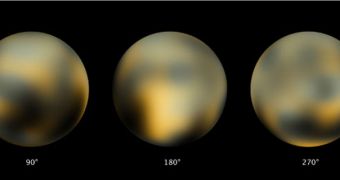Scientists operating the Hubble Space Telescope have recently conducted a new series of observations on Pluto, one of the most distant planets from the Sun. The images show the dwarf planet in about the same color it would appear to an astronaut approaching it on a spacecraft. But it's precisely this level of detail that now has astronomers puzzled. They were able to identify a number of colors on the planet, including gray, red and yellow, but they also discovered a mysterious, bright spot, which no one seemed able to make sense of, Space reports.
Experts know that some of the colors that appear to adorn the dwarf planet's surface are formed through the interactions between solar ultraviolet (UV) radiation and the methane that its atmosphere contains. But the bright spot, which is located alongside the planet's equator, has been determined to be very rich in carbon monoxide frost. “This is our best candidate, that it's carbon related,” Marc Buie, an expert at the Boulder, Colorado-based Southwest Research Institute (SwRI), said on Thursday in a teleconference. The Hubble data turned out to be “a real treasure trove of information in understanding the nature of Pluto and how it evolved and changes with time,” the scientist added.
Pluto will undoubtedly reveal more of its secrets to the NASA New Horizons probe, when the spacecraft will get there, in mid-2015. The machine has already traveled about half the distance between the Earth and the dwarf planet, and is scheduled to start sending back numerous new data sets once its science mission begins. Launched on January 19, 2006, the probe left on an Earth-and-solar-escape trajectory, at a speed of 58,536 kilometers/hour, or 36,373 miles/hour. It flew by Saturn in 2008, and is scheduled to reach Pluto in July 2015. After that, it will continue on in the Kuiper Belt.
This is not the first time Hubble collects data on Pluto. It conducted another survey in 1994, and the data gathered at the time were used to plot New Horizons' track. When the 1994 set was compared with the new one, gathered by the Advanced Camera for Surveys (ACS), massive differences in Pluto's appearance were discovered. They are owed mostly to the fact that the dwarf planet's elongated orbit takes it on a very wide path around the Sun. It takes about 248 years to orbit the Sun once, researchers add.

 14 DAY TRIAL //
14 DAY TRIAL //